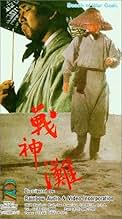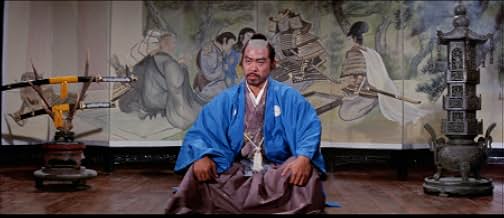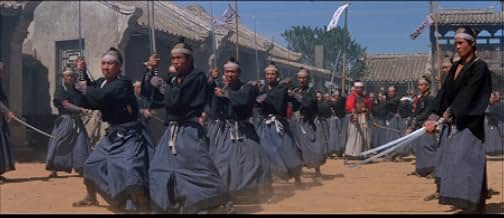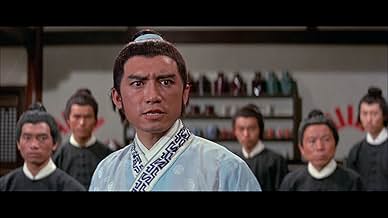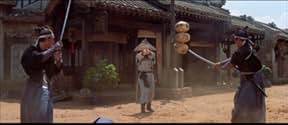अपनी भाषा में प्लॉट जोड़ेंDuring the Ming dynasty, a courageous swordsman gathers five other fighters and rallies the local fishermen to fight off a band of Japanese invaders.During the Ming dynasty, a courageous swordsman gathers five other fighters and rallies the local fishermen to fight off a band of Japanese invaders.During the Ming dynasty, a courageous swordsman gathers five other fighters and rallies the local fishermen to fight off a band of Japanese invaders.
फ़ीचर्ड समीक्षाएं
The narrator explains the political and social problems of the times as we see waves crash over the rocks. Jimmy walks alone to the city gate. The people are packing up and leaving. Some want to stay and fight but it seems hopeless. The Japanese are already there and demanding a ransom to spare the city.
Jimmy only needs one chopstick to kill one of the Japanese. He scratches his nose with the other then draws his sword to kill all the others except Shan Mao who flees.
Fabulous opening fight sequence. I consider this the best opening fight sequence of any martial arts movie up until 7/13/1973 the date of this movie's release.
This movie is famous for the lengthy battle sequence and has the record for the longest uninterrupted fight. Jimmy got it right by using a variety of weapons, plus props and other parts of the set manipulated into the fights. A battle this long has to be like a roller coaster ride or else it gets repetitive and boring. Like a roller coaster means twists and turns, speed up and slow down, left and right and every direction incessantly. Jimmy and the action directors got it just right here for an unforgettable and possibly unbeatable feature fight.
Is there anything to criticize about it? The fight sequence with the men using woven rattan shields and swords could have been choreographed better. It did not come across as effective or realistic but more as flashy acrobatics. This is a legitimate fighting style including the forward rolls. The Grand Master of All Martial arts Movie - Sifu Chia Liu-Liang- used these fighters and their techniques in a few Shaw Brothers movies and did it more realistically as to the fighting impact. My only other complaint was the flashy and blinding special effect in the last sword fight. I felt it was just not needed and added only a hokey element to it.
I rate this movie as one of the best martial arts movies of all times. My recommendation is meaningless as anyone who knows anything about this genre already knows about this movie.
Fabulous opening fight sequence. I consider this the best opening fight sequence of any martial arts movie up until 7/13/1973 the date of this movie's release.
This movie is famous for the lengthy battle sequence and has the record for the longest uninterrupted fight. Jimmy got it right by using a variety of weapons, plus props and other parts of the set manipulated into the fights. A battle this long has to be like a roller coaster ride or else it gets repetitive and boring. Like a roller coaster means twists and turns, speed up and slow down, left and right and every direction incessantly. Jimmy and the action directors got it just right here for an unforgettable and possibly unbeatable feature fight.
Is there anything to criticize about it? The fight sequence with the men using woven rattan shields and swords could have been choreographed better. It did not come across as effective or realistic but more as flashy acrobatics. This is a legitimate fighting style including the forward rolls. The Grand Master of All Martial arts Movie - Sifu Chia Liu-Liang- used these fighters and their techniques in a few Shaw Brothers movies and did it more realistically as to the fighting impact. My only other complaint was the flashy and blinding special effect in the last sword fight. I felt it was just not needed and added only a hokey element to it.
I rate this movie as one of the best martial arts movies of all times. My recommendation is meaningless as anyone who knows anything about this genre already knows about this movie.
At the heart of the incredibly titled Beach of the War Gods is a beautiful paradox, one built upon love and shame, it's wuxia mayhem by way of Kurosawa and Leone all filtered through the eyes of Jimmy Wang Yu. Whilst hand-to-hand combat had started to become the name of the game following the dawn of the 1970s, this film sees Wang Yu take a decisive step back from what he was more well-known for, to make a film in the genre that had previously dominated, the wuxia. Granted, it does look a little rougher around the edges than many of its contemporaries, but its ambition and scope are to be marvelled at. Wang Yu makes fabulous use of the wide frame with some brilliantly composed and thoroughly beautiful shots sprinkled throughout. It's enriched with depth, movement and a constant visual interest to keep you engrossed with wind machines regularly blasting away, waves crashing dramatically and fire adding powerful amounts of colour. And this is all before I mention the film's awe-inspiring and action-packed finale that brings 25 minutes of uninterrupted magnificence to the forefront. Yes, the characters and plot are exceptionally flimsy and the dialogue is superficial at best; yet the stripped-back approach works in Beach of the War Gods' favour, never intruding upon its gloriously bloody action and rushing towards its lengthy, epic final battle without any fat getting in the way.
In BEACH OF THE WAR GODS, an action-packed Hong Kong swordplay adventure from 1973, Jimmy Wang Yu rallies three fighters to help lead the men of a Chinese beach town in battle against the invading Japanese. One of the fighters is an expert knife thrower and comes with his own arsenal. It all leads quickly to a massive battle in the town streets. The swordfights are reminiscent of those found in Japanese samurai films, but with more action and vigor. (Interestingly, Wang Yu often made kung fu films with anti-Japanese themes, yet his films often reflected the influence of Japanese samurai films. This one, in particular, explicitly recalls Akira Kurosawa's SEVEN SAMURAI.)
The film could have used more buildup to the main battle, more training scenes, and more character development. After a simple setup, Wang Yu and company gather and prepare for battle. Then--boom!--the battle begins and lasts till the end of the film! The humble villagers we've met earlier are all now skilled uniformed fighters taking on hardened Japanese swordsmen with a range of sophisticated tactics. Action fans will love it, but those seeking a little more depth and substance may feel unsatisfied. Still, the impressive battle scenes are very well staged and photographed on a sprawling beach and a massive period backlot set. Wang Yu not only stars, but wrote and directed the film as well.
The film could have used more buildup to the main battle, more training scenes, and more character development. After a simple setup, Wang Yu and company gather and prepare for battle. Then--boom!--the battle begins and lasts till the end of the film! The humble villagers we've met earlier are all now skilled uniformed fighters taking on hardened Japanese swordsmen with a range of sophisticated tactics. Action fans will love it, but those seeking a little more depth and substance may feel unsatisfied. Still, the impressive battle scenes are very well staged and photographed on a sprawling beach and a massive period backlot set. Wang Yu not only stars, but wrote and directed the film as well.
I have forgotten the name of this film, then thx to my cousin I found it and watched it again. Great film, and a great performance.
I watched this film 30 times or more when I was 7-10 years old.
Real historical defence systems have been used in the film. That was very cool. For example, boiling oil. Traps in the coast. I have read about these methods in history.
Key figures in the war were accurately shown. Especially Leng Ping - a mercenary expert in throwing flying daggers. I liked his role in the war.
Wang Yu is a legend. Her charismatic stance in the movie impressed me a lot. Choosing black and white dresses for fighters was a good one. It's a beautiful film shot under the limited conditions of that time.
I watched this film 30 times or more when I was 7-10 years old.
Real historical defence systems have been used in the film. That was very cool. For example, boiling oil. Traps in the coast. I have read about these methods in history.
Key figures in the war were accurately shown. Especially Leng Ping - a mercenary expert in throwing flying daggers. I liked his role in the war.
Wang Yu is a legend. Her charismatic stance in the movie impressed me a lot. Choosing black and white dresses for fighters was a good one. It's a beautiful film shot under the limited conditions of that time.
The 70's kung fu craze that swept North American B movie theatres with the popularity of Bruce Lee reached its pinnacle with this movie. Following Lee's death there were many heirs presumptive that were supposed to take off as international kung fu stars, but never did. These include Bruce Li, Sonny Chiba, Jackie Chan (whose international popularity took hold many years later and in fact has surpassed Lee's in many ways), Chuck Norris, (who had inherent North American appeal, but lacked the mysticism surrounding Lee), and perhaps the most talented of them all, Jimmy Wang Yu.
Wang Yu movies had elements of myth, magic, history and violence that has been touched on, but not equaled by Ang Lee's recent Crouching Tiger, Hidden Dragon.
Old all the Wang Yu movies, Beach of the War Gods comes together in a way that truly raised the genre to new heights. A Chinese general arrives in a coastal town to fend off a Japanese invasion. While based on an historical incident, the movie employs all the trademark fantastical elements of great kung fu films. The various leaders of the Chinese and Japanese forces have special powers and skills and these are the 'hard men' of movies before the term existed.
The costumes and sets in Beach of the War Gods are something to marvel at. The fight scenes are seamless and bloody, and the pacing is enticing from beginning to end. While the characterizations are a bit thin, well..get with it..this is a kung fu movie, not Pride and Prejudice. All in all, a must-see for fans of the genre.
Wang Yu movies had elements of myth, magic, history and violence that has been touched on, but not equaled by Ang Lee's recent Crouching Tiger, Hidden Dragon.
Old all the Wang Yu movies, Beach of the War Gods comes together in a way that truly raised the genre to new heights. A Chinese general arrives in a coastal town to fend off a Japanese invasion. While based on an historical incident, the movie employs all the trademark fantastical elements of great kung fu films. The various leaders of the Chinese and Japanese forces have special powers and skills and these are the 'hard men' of movies before the term existed.
The costumes and sets in Beach of the War Gods are something to marvel at. The fight scenes are seamless and bloody, and the pacing is enticing from beginning to end. While the characterizations are a bit thin, well..get with it..this is a kung fu movie, not Pride and Prejudice. All in all, a must-see for fans of the genre.
क्या आपको पता है
- ट्रिवियाApart from the occasional order, the Japanese characters are actually speaking Cantonese.
- कनेक्शनReferenced in Gangsters: Enter the White Devil (1978)
टॉप पसंद
रेटिंग देने के लिए साइन-इन करें और वैयक्तिकृत सुझावों के लिए वॉचलिस्ट करें
विवरण
इस पेज में योगदान दें
किसी बदलाव का सुझाव दें या अनुपलब्ध कॉन्टेंट जोड़ें

